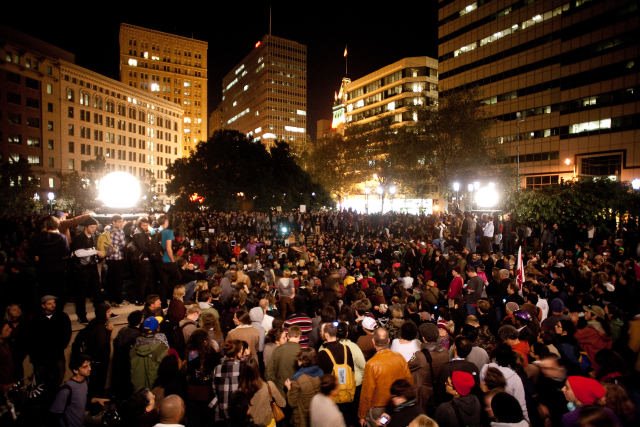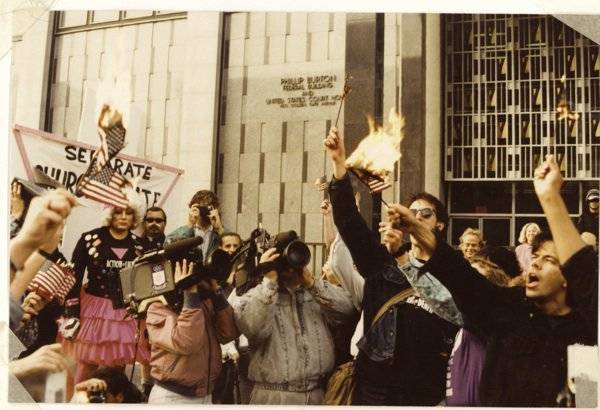I’m a jumble of mixed emotions watching the events at Occupy Oakland and SF unfold.
First of all, I’m not there. A few weeks ago, I was dropping by regularly at both camps, but when all the drama came down, I was 150 miles away in beautiful Fort Bragg on a long-scheduled two-week writing retreat. Which, BTW, has been wonderful.
My fellow writer, with whom I’m sharing this lovely retreat courtesy of some generous friends who lent us their place here, is much younger and works for a labor organization. Her roommate was one of the people who was dragged off to Santa Rita andheld in solitary confinement on $10,000 bail the other day. Her friends were up all night Monday waiting for the raid in Oakland, and again on Wednesday at OccupySF. For her, the mixed feelings are about guilt that she isn’t there sharing the work and the risk.
For me, it’s pure jealousy. Not, of course, of the people who got shot in the head with teargas canisters or the ones who spent a day or three in jail. But of the people who got to feel that incredible power and solidarity of the actions themselves, especially what I heard and saw of Wednesday night’s march in Oakland, the vigil for the wounded activist, Scott Olson, the 3,000-person general assembly (though the report on the OO website says 1,607 people voted) Of hearing that the planned raid on Occupy SF was called off because of the massive outpouring of support by new and seasoned activists. Of the energy and joy that comes from having such unity of purpose, and of knowing that YOU DID IT. Even though if I were there, a part of me would still be whispering, “They did it, not me.”
I can’t help it – I have Movement Envy. It was supposed to be us, who got that rush of seeing everything you’ve worked for come true and then some. I’ve worked for thirty years for this, and I didn’t get it. Some people who started their organizing just a few short years ago, not because they were not committed but because they were not even born when I started my activist life, were the ones who lit the spark that caught. It’s not because they were better at it than we were, which is not to take away from their genius – but trust me, we had genius too. It’s because their timing happened to be good.
Now some of my friends will say that all the fruitless work we’ve been doing for years has laid the groundwork for this. There are small ways that is obviously true. The forms of direct democracy that are prevalent in the Occupy movement – facilitation and consensus and hand signals and not having identifiable (and arrestable) leaders – come out of the various anarchist and anarchofeminist movements of the seventies and eighties. People would not now be talking about affinity groups and spokescouncils if we had not used those forms in the antinuclear movement, and we would not have used them then if the Spanish anarchists – a tragically doomed movement itself – had not developed them.
But in the larger sense, I don’t think it is really true that all the work we did has any direct relationship to the success of Occupy Wall Street and its progeny. This movement – or these movements, hard to know which is accurate yet – grew out of the material conditions of their time, here and around the globe. People used forms that they had learned from older movements, but if those forms had not been there, they would have used others, and if there were no models they wanted to copy, they would have invented their own. The form didn’t create the movement; the moment did.
Two years ago, I asked, “What do you do when it’s not your moment?” I ask that again, but with very different meaning. What do you do when the potentially revolutionary moment comes and it’s not yours?
This movement is not about those of us who have been doing labor organizing, queer liberation, feminist, anti-militarist, international solidarity, even anti-capitalist or anarchist organizing for years. That’s what’s driving some organizers crazy. They have spent years crafting careful and creative and sometimes quite effective campaigns to stop foreclosures, to tax the rich, to hold banks accountable, to oppose social service cuts, to cut military spending, to defend labor – it’s all great, it’s all still important, but this movement is neither a product nor an extension of those campaigns. This is a parallel movement, with a different class base, a very different trajectory, and a different style. (If you doubt that, you might want to check out this blog about some conflicts that have arisen in DC, between the “Stop The Machine” protest and the Occupy DC encampment, or this one about tensions between "organizers and organized" at OWS.) The people who have been studying and researching and planning and writing and speaking about these issues are going to be infuriated a lot of the time because people are going to be talking about their issues who know a lot less and have put in a lot less sweat and soul than they have on them. I empathize. I’ve been there.
I’m also highly ambivalent about the general strike that Occupy Oakland has called for Wednesday. I don’t believe they can pull off anything like a general strike. 3,000 is a lot of people to come to a protest and meeting, but the adult population of Oakland is 300,000. Maybe that 1% (hey – you are now the 1%! but in truth, not all of the people who attended the GA the other night were from Oakland) can actually mobilize sufficiently in a couple days to multiply itself by 20 or 30 – I’m not going to say they can’t. What they’ve been able to do so far is pretty amazing. You can’t achieve big if you don’t dream big.
Calling for a general strike on such short notice seems to me to trivialize the cost to most workers of taking a day off from work, when you have no union to protect you, which the vast majority of private sector workers do not. (In 2008, the private sector unionization rate for San Francisco-Oakland-San Jose was 12.1%, which is a lot higher than I would have guessed; I know almost no one who is in a private sector union.) I also feel like people without significant roots in the labor movement thinking they can organize a general strike in a few days is kind of disrespectful toward the people who have been organizing labor for years, and haven’t been able to do that.
Now there is no way I can stay home from work Wednesday, having just been on vacation for two weeks. I also don’t work in Oakland, but that’s kind of a cop-out. My coworkers can’t do it either – they need the days off for when there's no school. We have better benefits than nearly everyone, and that means we get two days’ bereavement leave when a parent or child dies. But they wouldn’t do it if they could, even if they knew about it. Most of them, the five hundred or so people who work at the law firm where I word process, have never been to a protest. The didn’t strike when the amount they have to pay for their health benefits went up by 30%. They didn’t strike when 20% of our coworkers were laid off. The first political action they take is not going to be giving up a precious vacation day for something that, if it is important to them at all, is important for philosophical reasons. And less privileged workers don’t get vacation days at all. If they don’t go to work on Wednesday, they won’t get paid, which they cannot afford, or they could even get fired, which they definitely cannot afford.
A strike is not individual workers deciding to take a day off. A strike is a collective action based on some collective ability to insulate individuals from the consequences. This very audacious and well-intentioned and creative movement just doesn’t have that capacity yet. If they can get the transit workers on board – and I think their contract probably forbids it, so it’s a very tall order – so the buses and trains don’t run, then private sector workers who’ve never seen a union organizer will have a way to say that they couldn’t get to work. Without that, what you’re asking for is, at best, a boycott.
The Great American Boycott in 2006 was organized over several weeks, and at the time they called it, they had already had half a million people march for immigration rights in Los Angeles. And honestly, that was no general strike either. 200,000 marched in SF, but they came from all over the Bay Area. Business was scarcely interrupted except in heavily Latino industries.
I don’t want to be a professional nay-sayer. (You might say, well you’re doing an awfully good job of what you say you don’t want to do.) Remember, this piece is about Movement Envy. My experience of movements that are (maybe) very different from this one might be limiting my view of what’s possible. So OO and OSF and ODC and OCD, go ahead and reach for those stars. But at the same time keep in mind that many of us are still stuck down here on earth.







